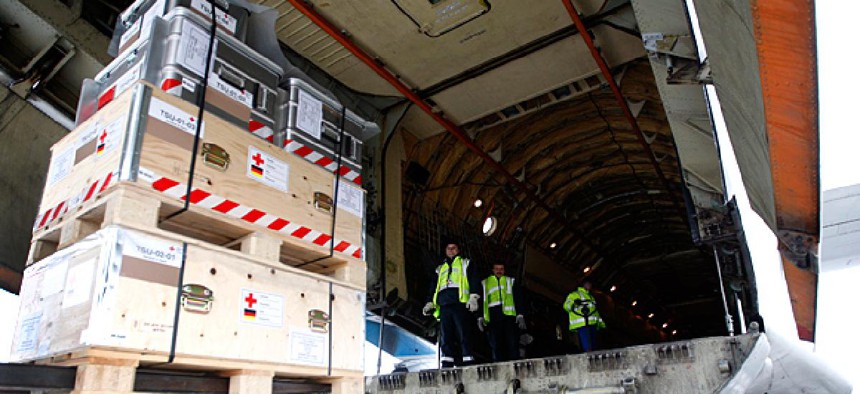TSA explores full body scans for fugitives hiding in cargo

Markus Schreiber/AP
Agency wants technology for screening stowaways inside containers; experts are skeptical.
The Transportation Security Administration is evaluating computer devices that would search cargo for stowaways, Homeland Security Department documents reveal. The technology being sought potentially would be applied to domestic and outbound international flights -- not necessarily trips to the United States, which involve cooperation with overseas governments.
The department’s Science and Technology Directorate, on behalf of TSA, is reviewing white papers and photographs of products submitted by vendors, according to an Aug. 9 request for information. The equipment must be capable of examining containers, crates and boxes that weigh more than 150 pounds and are large enough to hide a human being. Animals cannot be used as screeners. “Canines are not considered a technology for this,” DHS officials stated.
If the directorate can find viable tools, TSA then will weigh whether they should be included on a list of sanctioned devices for air carriers to deploy. “The ultimate goal is to place new systems capable of detecting stowaways onto the [Air Cargo Screening Technology List] from which industry can select, purchase and use,” officials stated. Private screening companies would pay to acquire the equipment, not the government.
The tools must capable of probing the contents of shipments before they are placed on cargo aircraft. This means the technology would have to see through sealed containers made of various types of wood, plastic, metal, cardboard and fiberglass. It is not clear if the devices would be used for passenger planes, all-cargo planes, or both.
Cargo screening attracted attention after foreign allies tipped off U.S. officials to explosive-carrying toner cartridges aboard U.S.-bound planes coming from Yemen. DHS failed to fulfill a post Sept. 11, 2001, mandate that all cargo on incoming international passenger flights undergo screening. But in May, the department set a Dec. 3 deadline for air carriers to search all U.S.-bound shipments for explosives.
Some experts say no such cargo screening devices exist right now. In May, aviation security consultant Douglas R. Laird told NBC News that “there really is no good technology to fully screen some of the larger cargo, like containers.”
The news report added “the newest computerized machines are good at sniffing out potential explosives in suitcases and packages, but aren't useful on such cargo as containers and other big items like high-end cars that end up on airplanes.”
Homeland Security’s request for information does not list specific technical requirements but does require the tools to be speedy and accurate: “Screening solutions must be effective (i.e., a high probability of detecting a stowaway, while maintaining a low probability of false alarms) and must be efficient (i.e., able to screen containers in a short amount of time).”
The equipment would be looking for humans among fish and meat, produce, flowers, paper, clothes, electronics, machine parts and other durable goods.
Officials want photos of the devices, as well as a description of the science behind the technology, including published literature if available.
Through the review, DHS aims to find out how many items these systems can process in an hour, as well as the amount of manual effort required. Assuming screening procedures last 12 hours a day, officials want to know how frequently the devices can be expected to fail during that time.
TSA missed an August 2010 deadline for full compliance with the counterterrorism law that ordered all cargo aboard domestic and U.S.-bound passenger planes be subjected to screening. The bomb materials originating from Yemen were hidden on passenger, all-cargo and interchangeable passenger-cargo planes, according to lawmakers. TSA, however, has been able to search 100 percent of cargo on stateside passenger flights since 2010.
NEXT STORY: The Wikipedia edit wars begin on Ryan's page






